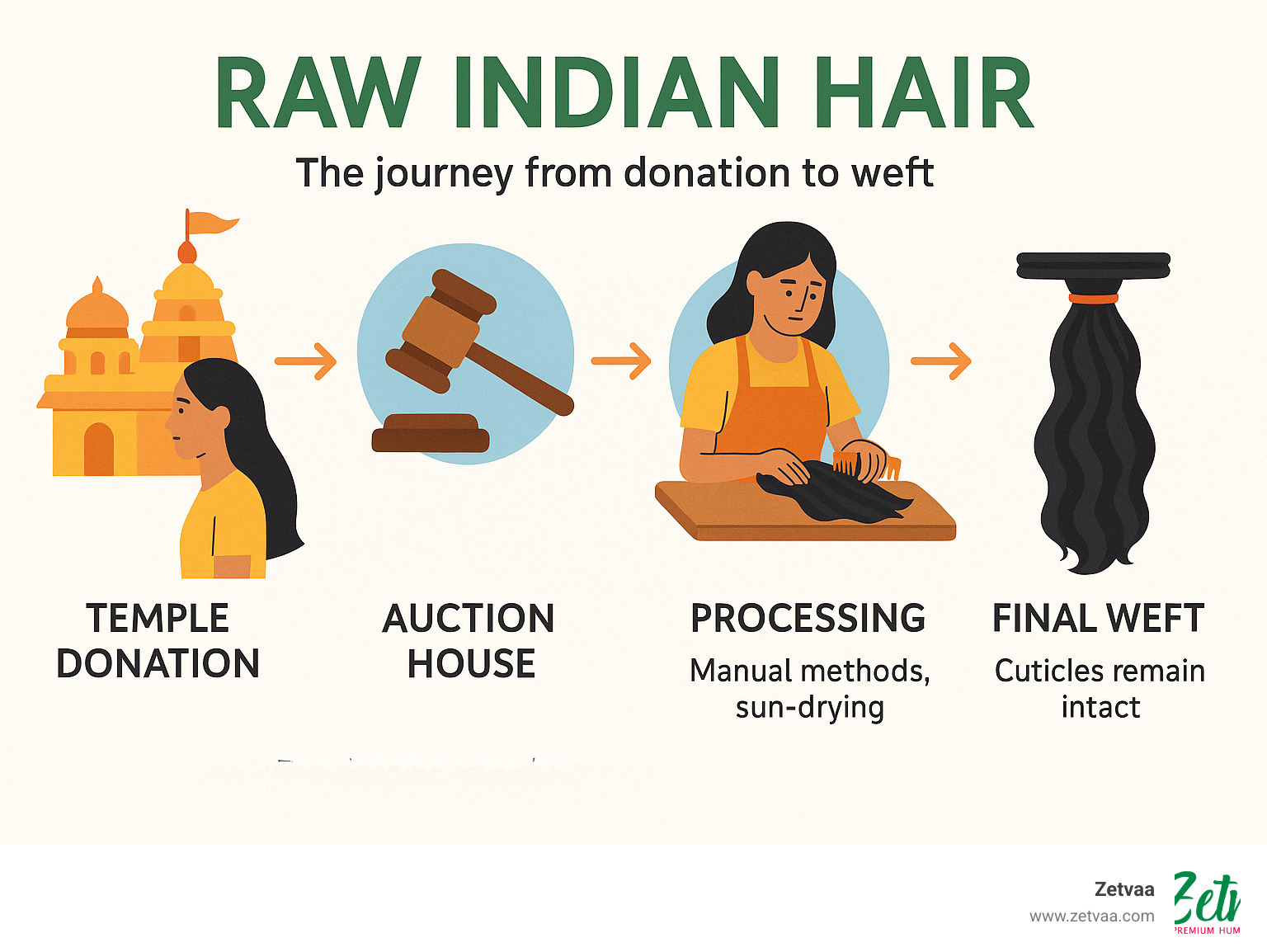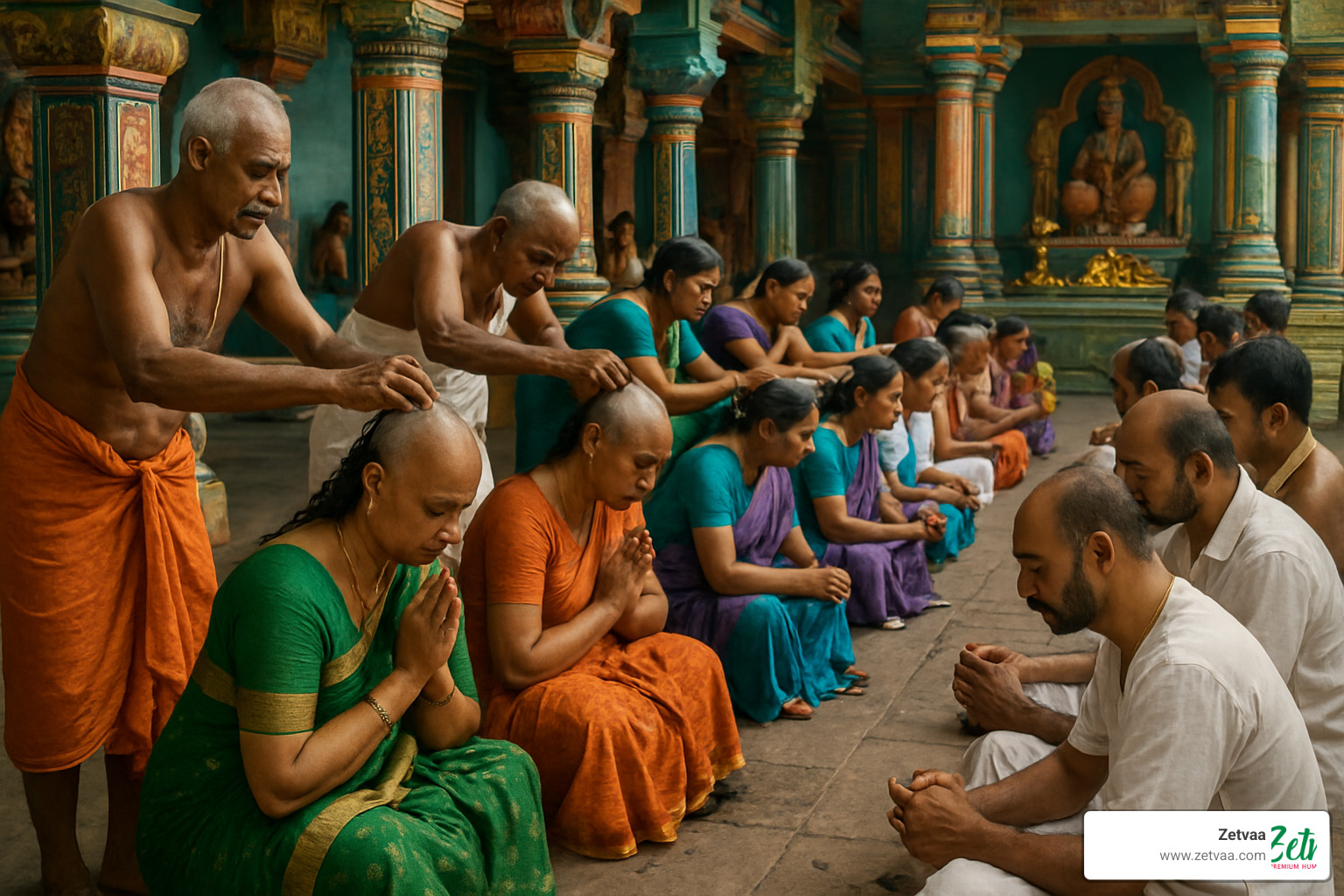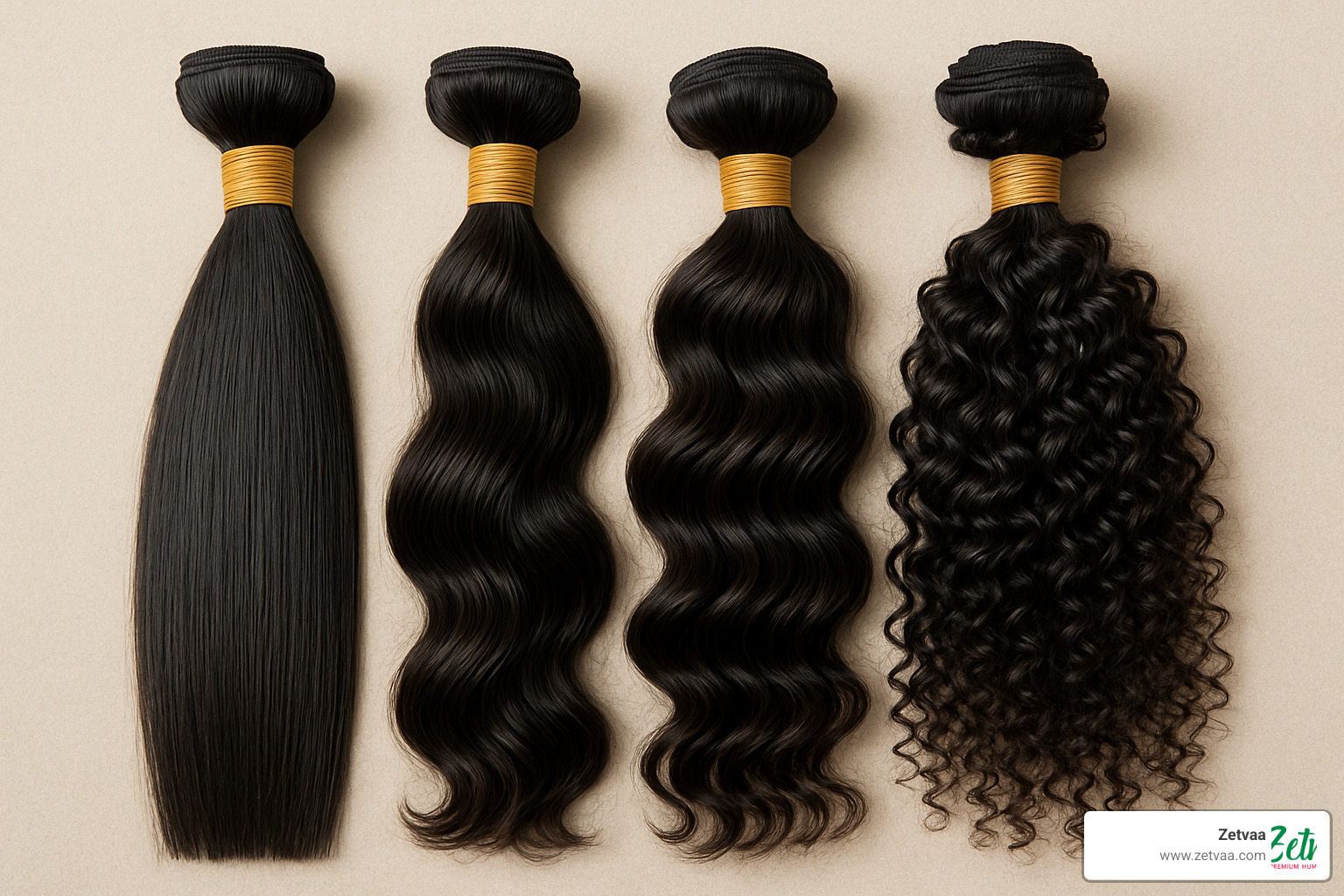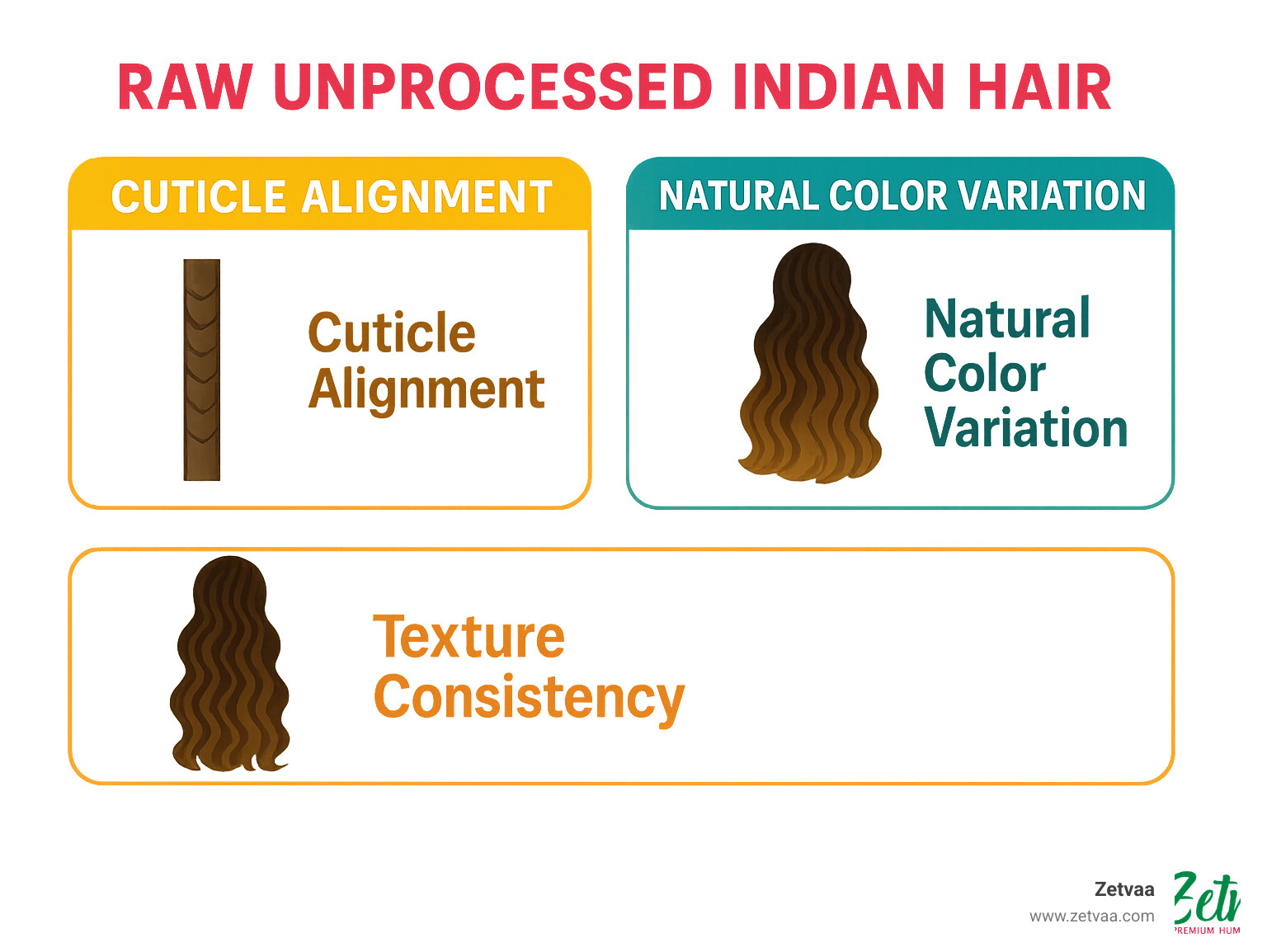From India with Love: Raw Unprocessed Virgin Hair You Need Now
Why Raw Unprocessed Indian Hair Is Taking Over the Beauty World
Raw unprocessed Indian hair is 100% virgin human hair sourced directly from South Indian temples, with intact cuticles and zero chemical treatments. Here's what makes it special:
- Single-donor bundles - Each bundle comes from one person, ensuring consistent texture
- Temple-sourced - Ethically collected from religious donations at Hindu temples
- Cuticles intact - Natural protective layer preserved for maximum durability
- Chemical-free - No bleaching, perming, or processing of any kind
- Lasts 1-2 years - Superior longevity compared to processed alternatives
- Can be dyed/styled - Heat-friendly and color-safe for versatility
The numbers tell the story: 95% of the world's hair extension market comes from Indian temples. These sacred donations fund community projects while providing the premium hair that discerning customers demand.
But here's the catch - not all "raw Indian hair" is created equal. The difference between authentic temple hair and cheaper alternatives can mean the difference between extensions that transform your look for years versus ones that tangle and shed within months.
"Temple hair auctions can easily cross half a million US dollars, making it accessible only to major buyers," according to industry insiders. This exclusivity explains why genuine raw Indian hair commands premium prices - and why it's worth every penny.

Why Raw Unprocessed Indian Hair Is the Gold Standard
When hair enthusiasts talk about the ultimate extension experience, raw unprocessed Indian hair always comes up. And for good reason - this isn't just marketing hype. There's something truly special about hair that comes straight from South Indian temples, completely untouched by chemicals or processing.
Think about it: 95% of the world's premium hair extensions trace back to Indian temples. That's not by accident. It's because this hair offers something you simply can't find anywhere else - authentic, cuticle-intact strands that can last up to two years with proper care.
What is Raw Unprocessed Indian Hair?
Here's the beautiful simplicity of raw unprocessed Indian hair: it's exactly what nature intended. No chemicals have ever touched these strands. No heat treatments. No artificial processing whatsoever. The cuticles remain perfectly intact and aligned, which is why you get that incredibly smooth, tangle-free experience.
But what makes Indian hair truly remarkable goes deeper than just the lack of processing. It's about the donors themselves. Many have followed traditional Indian lifestyles, with diets rich in coconut oil, turmeric, and other nutrients that naturally strengthen hair from within. These women often have never colored or chemically treated their hair, preserving every bit of its natural integrity.
Each bundle comes from a single donor, which means every strand in your bundle has the same natural texture and movement. No mismatched pieces, no inconsistent curl patterns - just beautifully uniform hair that behaves like your own.
Raw Unprocessed Indian Hair vs Brazilian & Peruvian
While other hair types have their place in the market, Indian hair offers something unique. The natural density and body of Indian hair creates fuller-looking extensions that blend seamlessly with most hair types. India's diverse climate - from humid coastal regions to dry inland areas - naturally creates hair that's incredibly adaptable and resilient.
The texture strikes that perfect sweet spot. It's strong enough to withstand regular styling and washing, yet fine enough to blend naturally with various hair types. This versatility means whether you have fine, medium, or coarse hair, Indian extensions will likely work beautifully with your natural texture.
Raw vs Virgin vs Remy: Know the Difference
Let's clear up the confusion around these terms, because understanding the difference can save you from expensive mistakes.
Raw hair is the premium tier - completely untouched and natural, lasting 1-2 years. Virgin hair has never been colored or permed but may have minimal processing, typically lasting 8-12 months. Remy hair focuses on aligned cuticles but may include chemically treated hair, usually lasting 6-8 months.
The key difference? Raw hair gives you the longest lifespan and most natural textures because nothing has been done to alter its original structure. When you invest in raw hair, you're getting hair in its most natural state - the same condition it was in when it was cut during the temple auctions.
More info about unprocessed hair
From Temple to Tresses: Ethical Sourcing & Craftsmanship

Picture this: thousands of devotees climbing temple steps at dawn, ready to offer their most precious possession - their hair. This isn't just commerce; it's centuries-old spiritual tradition that transforms personal sacrifice into community prosperity.
The journey of authentic raw unprocessed Indian hair starts in the sacred temples of South India, where hair donation is considered one of the highest forms of devotion. When devotees offer their hair, they're not just getting a haircut - they're participating in a ritual that funds schools, hospitals, and community projects across India.
These donations create a fair auction system where legitimate buyers compete for the finest hair. The proceeds flow directly back to temple communities, creating jobs and funding essential services. It's ethical sourcing at its most authentic - everyone wins.
The Journey: Collection, Sorting, Wefting
The moment hair is cut during the tonsure ceremony, temple workers spring into action. They immediately secure each ponytail with rubber bands, carefully marking which end was closest to the scalp. This rubber-band method is crucial - it keeps all the cuticles flowing in the same natural direction.
After collection, the real artistry begins. Skilled workers sort each bundle by length, texture, and quality. The hackling process removes shorter strands that could cause tangling, leaving only the finest, longest hair.
Then comes the triple-head wefting - a technique that creates incredibly strong seams. These aren't your average machine-sewn tracks. Each weft is reinforced three times, then sealed with a special glue seal that prevents shedding while keeping the hair flexible and natural-looking.
Manual vs Chemical Processing – Why It Matters
Here's where authentic raw unprocessed Indian hair facilities separate themselves from the competition. While mass-market processors rely on harsh chemicals to speed things up, ethical facilities stick to manual nit-picking and inspection.
This painstaking process means workers can only complete 7-10 bundles per day. Compare that to chemical processing that churns out hundreds of bundles in hours. The difference? Chemical treatments destroy the hair's natural structure, while manual processing preserves every precious cuticle.
The women-led factories we source from take incredible pride in their craftsmanship. These skilled artisans understand that rushing ruins everything. They carefully inspect each strand, sun-dry the hair naturally, and hand-select only the finest pieces for wefting.
Yes, it's labor-intensive. Yes, it takes longer. But when your extensions last up to two years instead of two months, you'll understand why this traditional approach creates such superior results.
Latest insight on temple economy
Product Roundup: Best Raw Unprocessed Indian Hair Textures & Types 2024

Ready to find your perfect match? Let's explore the beautiful world of raw unprocessed Indian hair options that are making waves in 2024. Each texture brings its own personality and styling possibilities to the table.
From wavy bundles that give you that effortless beach goddess vibe to straight bundles that scream sleek sophistication, there's something for every hair dream. Whether you're looking for bulk braiding hair, HD closures, frontals, or complete full-lace wigs, the raw Indian hair market has seriously stepped up its game this year.
The beauty of authentic temple hair lies in its incredible range - you can find everything from clip-ins for special occasions to permanent installs that'll have people asking for your hair care secrets. And yes, even 613 blonde options are available when you want to go lighter. Most vendors offer lengths from 12 to 30 inches, giving you the freedom to go from a cute bob to Rapunzel-length locks.
Raw Unprocessed Indian Hair Straight Bundles
There's something magical about raw unprocessed Indian hair in its straight form. Unlike the poker-straight processed versions you might be used to, authentic raw straight hair has this gorgeous natural movement that makes it look incredibly realistic.
The silky texture feels amazing between your fingers, and the natural luster catches light in all the right ways. No artificial coating or fake shine here - just the healthy glow that comes from hair that's never been damaged by chemicals. When you run your hands through it, you'll immediately feel the difference.
What makes these bundles truly special is how dye-friendly they are. Since the cuticles are completely intact, the hair takes color beautifully and evenly. You can go from natural black to honey blonde, and the hair will maintain its strength and shine throughout the process.
The versatility is incredible - wear it sleek and straight for work, add some curls for date night, and it bounces right back to its natural state after washing. Most people find that 16 to 22-inch lengths work perfectly for everyday styling, though the longer lengths are absolutely stunning for special occasions.
Natural Wavy & Curly Favorites
If you're dreaming of those perfect beach waves that look effortlessly gorgeous, raw Indian wavy hair is your answer. These aren't steam-processed waves that fall flat after a few washes - they're organic curls that maintain their beautiful pattern wash after wash.
The wave patterns vary slightly from bundle to bundle, which actually creates the most natural look when installed. Real hair isn't perfectly uniform, and these variations give you that authentic, "I woke up like this" vibe that's so hard to achieve with processed hair.
For our curly hair lovers, the steam-free patterns range from loose spirals to tighter coils, all maintaining their gorgeous shape without needing a ton of styling products. The curls have this beautiful bounce and resilience that processed curly hair just can't match.
Here's what's really amazing - you can temporarily straighten these textures with heat styling, and they'll return to their natural pattern after washing. It's like having multiple hairstyles in one investment.
Closures, Frontals & Wigs Worth the Investment
Let's talk about the game-changers - HD lace closures and frontals made with raw Indian hair. The technology has improved so much that the lace literally melts into your skin, creating the most natural-looking hairline you've ever seen.
These pieces feature transparent knots that are hand-tied with incredible precision. When installed properly, the hair appears to be growing directly from your scalp. No more obvious wig lines or unnatural-looking parts.
Full-lace wigs constructed with raw Indian hair offer ultimate styling freedom. You can part anywhere, throw your hair up in a ponytail, and even get caught in the rain without worrying about your hair looking fake. The density options typically range from 130% for a natural everyday look to 150% for those who want extra volume and glamour.
The investment is significant, but when you consider that these pieces can last up to two years with proper care, the cost per wear becomes incredibly reasonable. Plus, the confidence boost from having hair that looks and feels completely natural? Priceless.
More info about 100% human hair
Buying Guide: How to Spot Authentic Raw Indian Hair & Smart Shopping Tips

Shopping for raw unprocessed Indian hair can feel like navigating a minefield. With so many sellers claiming to offer "authentic temple hair," how do you know what's real and what's just clever marketing? Don't worry - we've got your back with some insider knowledge that'll help you shop like a pro.
Quality Indicators & Quick Tests
The truth is, authentic raw hair has telltale signs that processed alternatives simply can't fake. Start with the cuticle check - this is your best friend when evaluating quality. Gently run your fingers down the hair from root to tip, and it should glide smoothly. Now try the reverse, running your fingers from tip to root. You should feel some resistance, almost like tiny scales catching your skin. That's the intact cuticles doing their job.
The burn test might sound dramatic, but it's incredibly revealing. Take a single strand and carefully light it with a match. Real human hair burns slowly with a distinctive sulfur smell - think of it as the same scent you'd get from burning your own hair accidentally with a curling iron. If it melts instead of burning or smells like plastic, you're looking at synthetic fibers mixed in.
Here's a lesser-known trick: the water wave test. Wet a small section of the hair and watch how it behaves. Raw hair maintains its natural texture pattern when wet, while heavily processed hair often goes limp or reacts unpredictably to moisture.
Don't be alarmed by natural imperfections - they're actually good signs! Look for slight color variations throughout the bundle and the occasional silver strand. Perfectly uniform color from root to tip often screams chemical processing or hair from multiple sources mixed together.
Budget vs Quality: Why Cheap Isn't Cheerful
Let's talk numbers for a moment. Remember those temple auctions we mentioned earlier? When a single auction can exceed half a million dollars, those costs don't just disappear into thin air. They get passed down through the supply chain, which means authentic raw unprocessed Indian hair will never be bargain-basement cheap.
Think about it logically - if someone is selling "raw Indian temple hair" for $50 a bundle, the math simply doesn't add up. Between auction costs, manual processing labor, and fair wages for workers, authentic raw hair has a real cost floor that can't be ignored.
The manual processing alone tells the story. Authentic facilities produce only 7-10 bundles per worker per day because everything is done by hand. Compare that to chemical processing methods that can churn out 100 bundles in the same timeframe. Quality takes time, and time costs money.
Common Myths Debunked
The hair industry loves its marketing buzzwords, but some claims are pure fiction. The "12A grade" myth is probably the biggest offender. There's no universal grading system for human hair - suppliers literally make up their own grades. So when you see "12A+++" or "15A premium," it's meaningless marketing speak designed to justify higher prices.
Another persistent myth claims that raw hair can't be colored safely. This is completely backwards! Raw hair is actually the best candidate for coloring because those intact cuticles we keep talking about? They accept dye evenly and hold color beautifully. Processed hair with damaged cuticles is what gives you patchy, unpredictable color results.
Finally, let's address the ethical sourcing concerns. Some people worry that temple hair collection is exploitative, but this couldn't be further from the truth. These are voluntary religious donations made by devotees as part of their spiritual practice. The auction proceeds fund essential community projects like schools, hospitals, and housing. It's actually a beautiful example of how commerce can support communities when done ethically.
Care, Styling & Longevity Tips
Treat raw unprocessed Indian hair like the investment it is. With a simple, consistent routine, your bundles can look fresh for up to two years.
Daily & Weekly Routine
- Co-wash with a gentle, sulfate-free conditioner to cleanse without stripping moisture.
- Deep-condition once a week for 15-20 minutes to keep strands supple.
- Detangle from ends to roots with fingers or a wide-tooth comb while the hair is damp.
- Whenever possible, air-dry. If you need heat, stay under 400°F, use a thermal protectant, and seal ends with a light oil.
Coloring & Heat-Styling Guidelines
Raw hair’s intact cuticles accept color evenly. Always perform a strand test and lift in stages for dramatic changes. Lower heat settings preserve the natural texture and shine.
Storage & Travel Hacks
Store extensions in a breathable satin or silk bag. For trips, braid the hair loosely before packing to prevent friction. Before swimming, wet the hair with fresh water and coat with leave-in conditioner to guard against salt or chlorine.
Frequently Asked Questions about Raw Unprocessed Indian Hair
Let's tackle the most common questions we get about raw unprocessed Indian hair. These are the real concerns from customers who want to make smart investment decisions.
How long does raw Indian hair really last?
Here's the honest answer: authentic raw unprocessed Indian hair can last anywhere from 1 to 2 years with proper care. But that "with proper care" part is crucial.
The longevity depends on several factors. Your maintenance routine makes the biggest difference - gentle washing, regular deep conditioning, and minimal heat styling will extend the life significantly. How often you style and manipulate the hair also matters. Daily heat styling will naturally shorten the lifespan compared to air-drying and protective styles.
The quality of the original hair is equally important. Temple-sourced hair typically outlasts other sources because the donors often follow traditional lifestyles with minimal chemical exposure and nutrient-rich diets. Their hair structure is naturally stronger and more resilient.
We've had customers report their bundles looking great after 18 months of regular wear. That's pretty impressive when you consider most processed hair extensions need replacing every 3-6 months.
Can I dye or bleach raw unprocessed bundles safely?
This might surprise you, but raw unprocessed Indian hair is actually the best type for coloring. Those intact cuticles we keep talking about? They're your secret weapon for even, beautiful color results.
You can safely lift the hair several levels without the breakage you'd see with processed hair. The natural structure handles bleaching much better than hair that's already been chemically treated. We've seen stunning changes from natural black to beautiful blondes and vibrant fashion colors.
However, patience is key for dramatic color changes. Instead of trying to go from black to platinum in one session, gradual lightening over multiple appointments will keep your hair healthy and strong. Your colorist will thank you for bringing in quality hair that actually cooperates with the process.
Always do a strand test first - this isn't just salon advice, it's insurance for your investment. And please use quality hair products designed specifically for extensions. Your regular drugstore bleach isn't going to cut it here.
What makes temple hair more ethical than other sources?
The temple hair system is actually a beautiful example of ethical commerce that's been working for centuries. When devotees visit South Indian temples, offering their hair is a voluntary spiritual practice called tonsure. It's deeply meaningful - not a financial transaction.
Here's where it gets interesting: the temples then sell this donated hair through transparent public auctions. These aren't shady backroom deals - they're legitimate business transactions where the highest bidder wins. The proceeds go directly back into community development projects like schools, hospitals, housing, and infrastructure improvements.
This creates a sustainable economic cycle that benefits entire communities. The temples get funding for social programs, local processing facilities provide employment (especially for women), and customers worldwide get premium hair. Everyone wins, and cultural traditions are preserved and respected.
Compare this to other sourcing methods where the supply chain can be murky and the benefits don't reach the communities providing the hair. Temple hair sourcing is transparent, traceable, and genuinely beneficial to the source communities.
The system has been refined over generations, creating accountability and fairness that's rare in global commodity markets. When you choose authentic temple-sourced hair, you're supporting this ethical ecosystem.
Conclusion
Genuine raw unprocessed Indian hair offers best longevity, ethical sourcing, and styling freedom. By choosing temple-sourced bundles, you invest in hair that can last 1–2 years, support community projects in India, and deliver the most natural look.
Zetvaa’s curated, single-donor collections meet the strict standards we’ve discussed, so you can shop with total confidence.
Ready for hair that performs as beautifully as it looks? Explore our textures, pick your perfect match, and experience the Zetvaa difference today.





